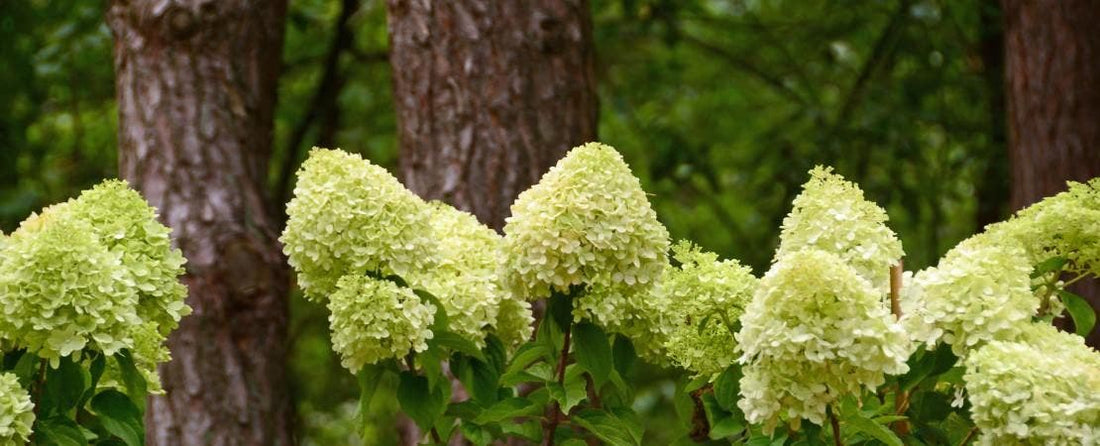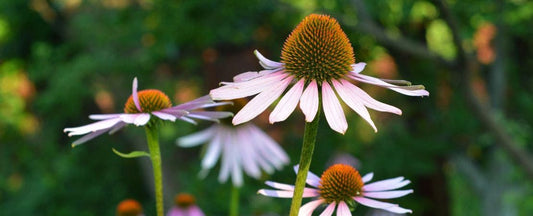Your Guide to Growing and Caring for Panicle Hydrangeas

Known for Their Conical Shaped Blooms and More Tolerance for Sun
Panicle hydrangeas, or Hydrangea paniculata, are a favorite among gardeners for their elongated flower clusters and hardiness. With a variety of cultivars, including the compact Fire Light Tidbit®, these versatile shrubs can enhance any garden space, whether in borders or containers. This guide will help you identify panicle hydrangea bushes, as well as provide essential tips and instructions on how to care for and grow them.
Identifying Panicle Hydrangeas
Panicle hydrangeas are known for their large, conical flower heads that can reach up to 18 inches in length. Unlike the rounded flower heads of other hydrangea species, panicle hydrangeas have a distinctive shape that makes them easily recognizable. The flowers typically start white or greenish-white, turning pink, red, or even burgundy as they mature. This color transition is one of the most appealing features of panicle hydrangeas. The color transition is is triggered by cooler temperatures and cooler night temperatures. So, if you're in a warm Zone, you'll enjoy the beautiful and long-lasting white flowers.
Video tips from Jess @YouCanDoItGardening
Tips for How to Identify Panicle Hydrangeas
Flower Shape: Large, conical clusters (panicles) of flowers.
Color Transition: Flowers change color as they age.
Leaves: Dark green, oval leaves with a rough texture.
Growth Habit: Can vary from compact shrubs to larger, tree-like forms.
Popular Varieties of Panicle Hydrangeas
While the Fire Light Tidbit® is a notable variety due to its compact size and vibrant color transformation, Wayside Gardens offers several attractive panicle hydrangea varieties:
Limelight Hydrangea (Hydrangea paniculata 'Limelight')
- Known for its lime-green flowers that turn pink and burgundy in the fall.
- Larger growth habit, reaching up to 8 feet tall and wide.
Little Lime® Hydrangea (Hydrangea paniculata 'Jane')
- A dwarf version of the Limelight, perfect for smaller spaces.
- Grows up to 3-5 feet tall and wide, with similar lime-green to pink flower color change.
Quick Fire® Hydrangea (Hydrangea paniculata 'Bulk')
- One of the earliest blooming varieties, with flowers that turn deep red in the fall.
- Grows up to 6-8 feet tall and wide.
Bobo® Hydrangea (Hydrangea paniculata 'ILVOBO')
- A compact variety with abundant white flowers that turn pink.
- Grows up to 3 feet tall and wide, making it ideal for small gardens or containers.
Fire Light® Hydrangea (Hydrangea paniculata 'SMHPFL')
- Similar to Fire Light Tidbit® but larger, with flowers turning a deep pink-red in late summer.
- Grows up to 6-8 feet tall and wide.
Planting Panicle Hydrangeas
Choosing the right location and planting at the optimal time are crucial for the success of your panicle hydrangeas.
Best Planting Time
- Early spring or fall.
Site Selection
Sunlight: Panicle hydrangeas thrive in full sun to partial shade. In hot climates, provide afternoon shade to protect from intense sun.
Soil: Well-drained soil is essential. Hydrangeas prefer slightly acidic to neutral soil.
Planting Steps
Prepare the Site: Dig a hole twice as wide and the same depth as the root ball.
Amend the Soil: Mix in compost or well-rotted manure to improve soil fertility and drainage.
Planting: Place the hydrangea in the hole, ensuring the top of the root ball is level with the surrounding soil. Backfill the hole with soil, pressing gently to remove air pockets.
Watering: Water thoroughly after planting to help settle the soil.
Caring for Panicle Hydrangeas
Proper care will ensure your panicle hydrangeas remain healthy and vibrant.
Watering: Keep the soil consistently moist, especially during the first year after planting.
NOTE: Deep watering once a week is preferable to frequent shallow watering.
Fertilizing: Apply a granular rose fertilizer in early spring to promote healthy growth and abundant blooms.
Pruning: Panicle hydrangeas bloom on new wood. Prune in late winter or early spring, cutting back stems by about one-third of their total height. This encourages new growth and more flower buds.
Remove any dead or damaged wood to maintain the plant's shape and health.
Mulching: Apply a 2-3 inch layer of mulch around the base of the plant to retain moisture and regulate soil temperature.
Common Issues and Solutions
Pests and Diseases
Panicle hydrangeas are generally resistant to pests and diseases. However, they can occasionally suffer from aphids, spider mites, or powdery mildew.
Regular inspection and prompt treatment with insecticidal soap or neem oilcan keep pests at bay. For powdery mildew, ensure good air circulation and avoid overhead watering.
Winter Protection
While hardy in zones 3-9 (depending on the variety), young plants may benefit from a layer of mulch or straw to protect the roots from extreme cold.
Enhancing Your Garden with Panicle Hydrangeas
Panicle hydrangeas are not only beautiful but also versatile, fitting well into various garden designs. Whether you choose to plant them as a focal point in your garden or use them to create stunning hedges, their long-lasting blooms will provide continuous interest from midsummer to the first frost.
Landscape Uses
Borders: Their tall, arching branches and large blooms make them perfect for adding height and structure to garden borders.
Containers: Compact varieties like Fire Light Tidbit® and Bobo® are excellent choices for container gardening.
Hedges: Larger varieties can be planted in rows to create beautiful, flowering hedges.
Enjoy the one-of-a-kind beauty and resilience of panicle hydrangeas.





